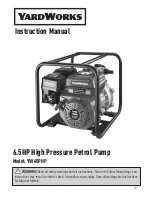
6
cAUtion
•
d
o
not
touch
the
SWItch
WIth
Wet
fIngerS
. t
ouchIng
a
SWItch
WIth
Wet
fIngerS
may
reSult
In
electrIc
Shock
.
•
d
o
not
alloW
chIldren
to
play
on
or
around
the
unIt
or
It
may
reSult
In
Injury
.
•
t
he
heat
exchanger
fInS
are
Sharp
enough
to
cut
,
and
may
reSult
In
Injury
If
Improperly
uSed
. t
o
avoId
Injury
Wear
glove
or
cover
the
fInS
When
WorkIng
around
them
.
•
d
o
not
touch
the
refrIgerant
pIpeS
durIng
and
ImmedIately
after
operatIon
aS
the
refrIgerant
pIpeS
may
Be
hot
or
cold
,
dependIng
on
the
condItIon
of
the
refrIgerant
floWIng
through
the
refrIgerant
pIpIng
,
compreSSor
,
and
other
refrIgerant
cycle
partS
. I
t
may
reSult
In
your
handS
gettIng
BurnS
or
froStBIte
If
you
touch
the
refrIgerant
pIpeS
. t
o
avoId
Injury
,
gIve
the
pIpeS
tIme
to
return
to
normal
temperature
or
,
If
you
muSt
touch
them
,
Be
Sure
to
Wear
proper
gloveS
.
•
I
nSulate
SuctIon
pIpIng
to
prevent
condenSatIon
.
•
B
e
careful
When
tranSportIng
the
product
.
•
t
ake
adequate
meaSureS
to
prevent
the
outdoor
unIt
from
BeIng
uSed
aS
a
Shelter
By
Small
anImalS
. S
mall
anImalS
mak
-
Ing
contact
WIth
electrIcal
partS
may
reSult
In
malfunctIonS
,
Smoke
,
or
fIre
. I
nStruct
the
cuStomer
to
keep
the
area
around
the
unIt
clean
.
•
I
f
the
conventIonal
refrIgerant
and
refrIgerator
oIl
are
mIxed
In
r410a,
deterIoratIon
WIll
reSult
.
•
t
hIS
aIr
condItIoner
IS
an
applIance
that
Should
not
Be
acceS
-
SIBle
to
the
general
puBlIc
.
•
a
S
deSIgn
preSSure
IS
450
pSI
(3.1 mp
a
),
the
Wall
thIckneSS
of
fIeld
-
InStalled
pIpeS
Should
Be
Selected
In
accordance
WIth
the
relevant
local
,
State
,
and
natIonal
regulatIonS
.
notice
r
efrIgerant
l
IneS
cAUtion
t
he
compreSSor
pve
oIl
for
r-410a
unItS
IS
extremely
SuS
-
ceptIBle
to
moISture
aBSorptIon
and
could
cauSe
compreSSor
faIlure
. d
o
not
leave
SyStem
open
to
atmoSphere
any
longer
than
neceSSary
for
InStallatIon
.
Use only refrigerant grade (dehydrated and sealed) copper
tubing to connect the air conditioner with the indoor evapora-
tor. After cutting the tubing, install plugs to keep refrigerant
tubing clean and dry prior to and during installation. Tubing
should always be cut square keeping ends round and free
from burrs. Clean the tubing to prevent contamination. The
liquid line must be insulated if more than 50 ft. of liquid line will
pass through an area that may reach temperatures of 30°F
or higher than outdoor ambient. Never attach a liquid line to
any uninsulated portion of the suction line.
Do NOT let refrigerant lines come in direct contact with plumb-
ing, ductwork, floor joists, wall studs, floors, and walls. When
running refrigerant lines through a foundation or wall, open-
ings should allow for sound and vibration absorbing material
to be placed or installed between tubing and foundation. Any
gap between foundation or wall and refrigerant lines should
be filled with a pliable silicon-based caulk, RTV or a vibration
damping material. Avoid suspending refrigerant tubing from
joists and studs with rigid wire or straps that would come in
contact with the tubing. Use an insulated or suspension type
hanger. Keep both lines separate and always insulate the
suction line.
Insulation is necessary to prevent condensation from forming
and dropping from the suction line. Insulation tube with 3/8”
min. wall thickness is recommended. In severe conditions
(likely to exceed 86°F and a relative humidity of 80%) 1/2”
insulation may be required. Insulation must be installed in a
manner which protects tubing and connections from damage
and contamination.
Please use a HVAC flushing solvent to clean lineset of any
oil or debris from the existing system.
note:
If changing refrigerant, the indoor coil and metering
device must be replaced.
cond Unit
tons
Allowable line set diameter
liquid
Suction
3/8
7/8
1 1/8
3.5
x
x
x
4
x
x
x
5
x
x
x
x
: Allowable combination







































